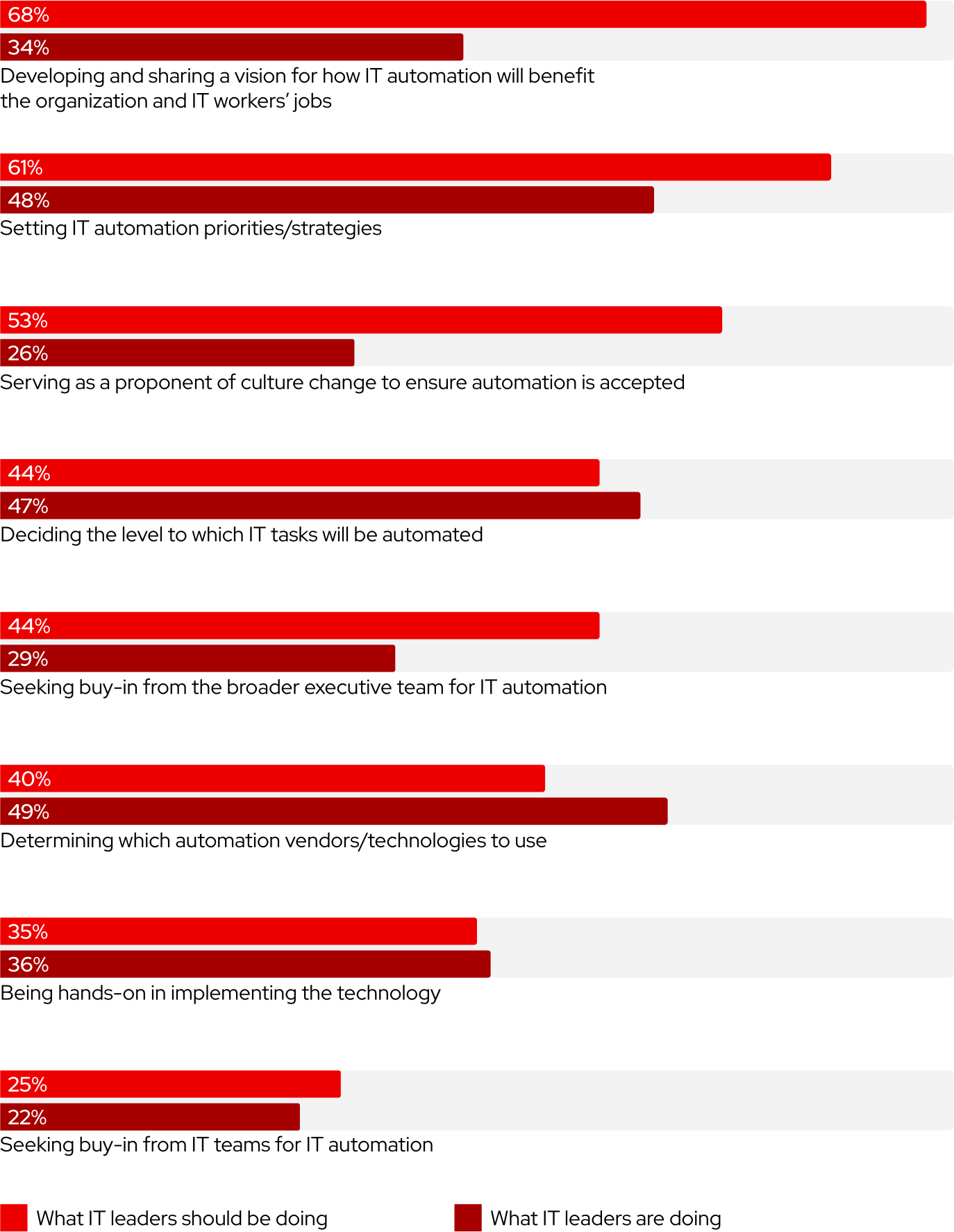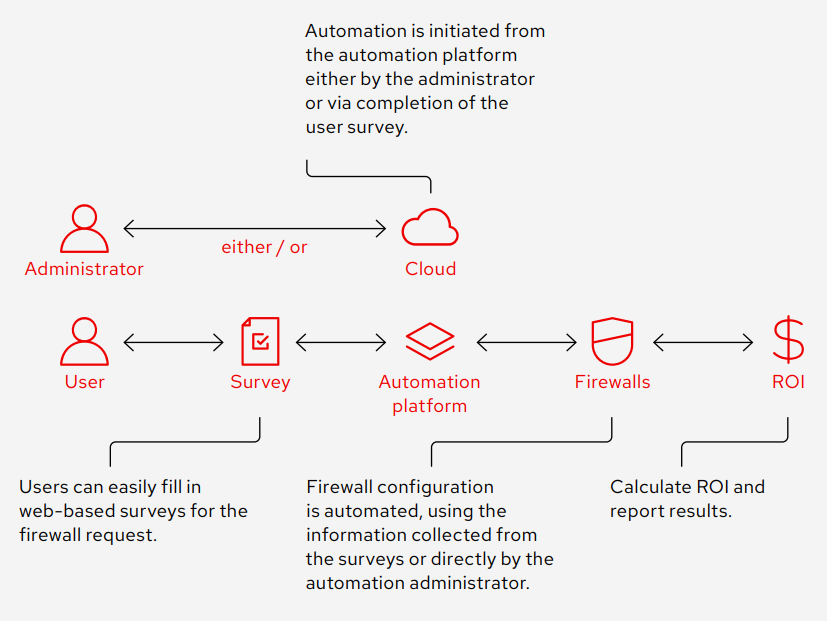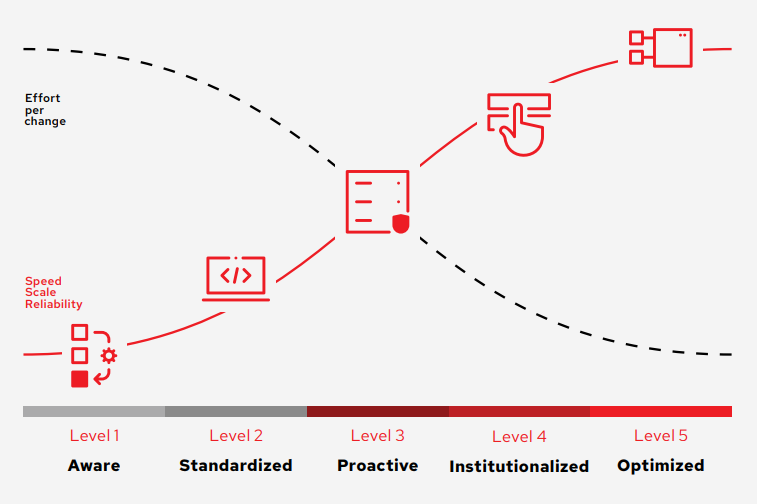The automation architect's handbook
Introduction
Automation is now at the core of many organizations’ technology strategies. In response to the need to innovate faster, manage increasingly complex IT environments, accommodate new development approaches, and meet financial objectives, companies are making automation a priority. In fact, 80% of surveyed business executives said that adopting IT automation is “extremely important” to the future success of their business.¹
Many organizations already have some task-centric automation in place, but automating at scale across teams, geographies, platforms, and processes to deliver greater value is becoming a primary focus.
Enter the automation architect, an emerging role that helps organizations adopt an automation-first mindset and achieve a range of business, financial, and transformation goals.
Automation architects are essential for implementing comprehensive automation initiatives—like end-toend automation of IT processes—and ensuring good automation practices across the organization.
Automating a single task can be relatively simple, but you can achieve far more value from a well-planned, organization-wide automation strategy. In an increasingly digital world, companies need to be faster, more innovative, and more agile than their competitors. Strategic automation can help businesses achieve goals that depend heavily on technology. Even so, there are challenges to overcome. Maintaining governance and policies, achieving cultural transformation, building skills, managing scalability and security risks, and controlling and reusing trusted automation content must be considered when planning your automation strategy.
The role of the automation architect is crucial for addressing these challenges and realizing the full value of automation. In this e-book, we map the steps required to lead an organization beyond task-centric automation toward an enterprise-wide strategy.
By using an automation platform across teams, IT organizations can deliver faster service delivery, more agility for the business, and end-to-end integrated process visibility that drives scale, consistency, security, and transparency.2
Enter the automation architect, an emerging role that helps corporations build an automation first mindset.
Getting started
Organization-wide automation is an ongoing journey, rather than an end state. According to Forrester, “automation is a cycle of sensing and adapting that relies on gathering and evaluating critical information, sequencing a response, and executing. Continual fine-tuning of this cycle propels your business to a new level of adaptation and customer experience.”3
Consider mapping your organization's automation maturity across the six key competencies outlined in the Forrester report, “Gauge Your Infrastructure Automation Maturity.”³ Figure 1 describes these competencies and how you may apply these competencies in your organization.
6 key competencies for automation transformation3
Strategy
To optimize your infrastructure automation strategy, you must first have a full understanding of where automation lives in your infrastructure and operations (I&O) organization and where you might be duplicating efforts. Strive to eliminate islands of automation.
Process
All automation relies on 9 key dimensions: data acquisition, comprehension, determinism, robotics quotient, operating effect, governance and auditability, human machine interaction, human effect, and conversational intelligence. You need a full understanding of these dimensions to determine process impact.
Prioritization
If you’re like most enterprises, multiple infrastructure automation projects are ongoing in your organization. You must evaluate, prioritize, and align these to a consistent strategic roadmap.
People
Infrastructure automation requires new skill sets for operations professionals. Focus on infusing them with data science, algorithm development, industrial engineering, and artificial intelligence and machine learning (AI/ML) expertise.
Structure
An efficient strategy requires discrete organizational units focused on domain, automation, and services expertise. Organize automation strike teams to ensure efficiency between teams and prompt deliverables.
Operations
Don’t graft infrastructure automation onto an existing operating model; instead, redefine your operating model to interweave new process workflows. Share automation knowledge, best practices, and roadmaps throughout your organization.
Red Hat® Services consulting engagements use a 3-phased approach to help you expand automation across domains and plan your automation journey.
Key questions to assess your organization
Consider what might be keeping your organization from meeting business objectives. Use the following questions to understand your organization's current state of automation.
Understand your organization's current state of automation
- Which processes can you automate to deliver more value?
- Which simple but repetitive processes can be automated first to deliver and demonstrate results?
- Are there automation solutions currently in use that will be difficult to manage if a subject matter expert becomes unavailable or moves on?
- Are there competing automation solutions in use by different teams, or tool-specific automation capabilities that need to be joined together to automate a process?
- Are there key executive initiatives that can be improved with automation?
- Can automation be used to relieve over-burdened teams or unite disparate functions?
With a better understanding of your organization’s automation maturity, you are ready to develop automation goals and begin the transformation process
68% of business executives agree that IT automation at their organization is now a "must have". [4]
80% of business executives say that adopting IT automation is “extremely important” to the future success of their organization. [4]
Set automation goals
The journey to comprehensive, enterprise-wide automation is an iterative process with no single way to measure success. To be effective, goal alignment is imperative.
Often, executives and implementers are not aligned on goals and use cases. For example, a Harvard Business Review study found a disconnect between what associates think IT leaders should be doing and what they are actually doing to advance IT automation. In most cases, there is a greater than 10% gap between action and expectation of actions in setting IT automation priorities.⁵
79% of business executives say that a unified, organization-wide approach is “extremely important” or “very important” when implementing IT automation.5
55% of business executives are concerned about their ability to successfully execute a digital transformation strategy without IT automation.5
Uniting viewpoints
Automation architects can bring together differing views by focusing on the following concepts.
Align to business objectives
Connect automation efforts with business challenges and goals. This approach helps you identify where to automate and create top-down requirements for success. For example, you could automate patching to boost system security and stability and meet business needs for improved uptime. When planning your automation journey, focus on outcomes rather than outputs.
Set realistic goals and outcomes
Establish achievable goals. Cost savings and return on investment (ROI) are common priorities, but other goals might include improving security risk management, increasing process accuracy, freeing time for innovation, and increasing business stakeholder satisfaction. Realistic goals should align with your organization’s current skills while encouraging teams to learn and expand their abilities as you progress along your automation journey. Over time, your teams’ automation skills will improve and they can increase the scope and complexity of their automation projects accordingly.
For example, a team might start by automating a single highly repetitive task and demonstrating cost and efficiency benefits from that project. They can then expand and apply that automation to other related tasks, full processes, or even organization-wide implementations.
Optimize processes, then automate
As you define your automation projects, assess the processes that you want to automate. Are they efficient? Do they contain outdated or unnecessary steps? Determine if processes can be improved before you automate them to optimize efficiency. If you find that a process is inefficient, address the inefficiency before automating the process.
Define and document automation success
There is no single way to measure automation success. Start small, demonstrate value, expand conservatively, and repeat. Consider working across your organization to identify an initial automation opportunity that can be easily reported back to executive teams.
Figure 3 shows an example automation workflow. In this example, misconfigured firewall rules cause an increase in incident management tickets and change requests for network and IT teams.
Automation is applied to fix the issue and reduce the number of tickets and change requests. These reductions are then mapped to cost savings and improved IT customer service.
Governance is also applied through automation so that updates are made consistently and according to a defined, auditable process.
Finally, the measured metrics can be shared across the organization and with executives and business stakeholders to show the value of automation.
In its 30-criterion evaluation of infrastructure automation platform providers, The Forrester Wave™: Infrastructure Automation Platforms, Q1 2023 report identifies, analyzes, and scores the 11 most significant infrastructure automation providers.6
Once you can demonstrate successful automation in a simple scenario and show how automation replaces manual processes, you can increase the number and types of use cases and the scope of your automation.
Share and build on successes
Work to accomplish incremental successes over short periods. Document and promote each win, then ask your broader organization for ideas on how they too can realize value from automation. This approach establishes a base so others can build upon your experiences and deliver greater value.
Employ a crawl, walk, run approach
Organizations that begin their automation journey with more complex— rather than simpler—projects often struggle to expand their automation beyond a single use case.
For example, within the network domain, implementing a web server involves many configuration management tasks.
You might need to reserve a public Internet Protocol (IP) address, requiring you to interact with a network system to get the address. Additionally, you will need to assign a Domain Name System (DNS) for that address, open firewall ports, configure a load balancer, and advertise that IP address through your edge routers, as well as implement any required local networking changes.
Compared to the IP address example, the DNS example is much more complex and time consuming, and reporting success will be more difficult. In this case, an iterative approach would automate the IP address request process first, then add other automation steps to handle the DNS-related tasks once your initial steps are working as expected.
See how real customers gain value from automation.
Organizing automation assets and training staff
Before you begin automating, prepare your organization for success using these steps :
- Identify existing automation inventory.
- Create a centralized repository of trusted content.
- Use training resources and a free product trial to help your staff become familiar with the content repository and the automation platform.
A centralized repository is an essential element for ensuring reuse of trusted automation content, whether you build it internally, use certified automation content, or rely on community-developed content.
This repository can help you implement control and governance of automation from the start, yield significant benefits as your organization progresses toward holistic automation. Skill development and sharing best practices, experiences, and accomplishments can help you build a community of practice. Sometimes called centers of excellence, communities of practice are important for creating an automation-first culture and mindset throughout your organization.
Understand your inventory
How are your IT assets organized and managed? Identify which assets you have, how they are configured, and how you will keep track of them over time.
Define a source control repository
How will you track changes to your automation content? Create consistent, security-focused methods for recording and controlling changes to your assets.
Train your staff
Do your staff have the skills they need to automate successfully? Train staff on concepts like source control, testing protocols, and best practices.
Try Red Hat Ansible® Automation Platform and access the Red Hat Customer Portal for documentation, helpful videos, discussions, and more.
Learn more about planning a strategy for organization-wide automation.
Advance a culture of automation
Successful end-to-end automation requires not only a technology change, but also a change in mindset across your organization. Communities of practice can help transform how your organization thinks about automation, and our services team is here to help. We work alongside our customers to establish new automation-first mindsets and ensure success.
Many automation resources are readily available, including training on concepts like source control, testing protocols, and best practices. Automation architects and others who are responsible for moving automation forward can use these resources to begin building trust across the organization.
Train behaviors
Build trust and gain buy-in for a holistic approach by creating a shared understanding of how automation can work between teams.
Use demonstrations and events like brown bag lunches to show how the solution works and create interest. Once your community of practice is engaged, offer more hands-on and in-depth sessions for interested teams. More formal training can follow.
Increase visibility
Look for ways to promote interest in automation. For example, create a dashboard to share successes and offer a technical code-a-thon challenge that the broader team can help to solve, with recognition or a reward for the winner.
This approach gamifies the automation process, increases visibility across domains, and trains the behavior of frequent iteration.
Did you miss AnsibleFest?
Access the insights that lead to culture change and workforce transformation. Start with the AnsibleFest video playlist on our YouTube channel.
Approaches at a glance
- Identify a champion or executives to talk about the value of automation, including staying competitive and innovating quickly.
- Share results and successes as a way to build trust and legitimacy. • Highlight and reuse trusted content to save time.
- Find the best teams for automation opportunities and work with them to create content and implement automation.
- Offer demonstrations and use cases that teams can relate to.
- Once the community of practice has momentum, develop standards boards and policies.
Help your teams get started
Work with teams to assess their processes and find opportunities for automation. Look for repetitive tasks that cause delays and are not central to the team’s role.
Perform technical due diligence and offer an automation solution that provides enterprise scalability. Look for solutions that make it easier to adopt new automation, access ecosystem support, and automate across domains and existing tools. Many automation solutions require agents or software to be installed on remote systems, which can create a barrier to implementation. Also, look for solutions that offer simple content creation and certified content to speed progress.
Empower employee-led automation
Offer automation training to help teams throughout your organization get started. A bottom-up approach where employees can suggest automation projects via a centralized platform helps gather high-value ideas and encourages a culture of automation. It’s important not to force automation projects—take advantage of your organization’s existing tools and content.
Manage up
To gain buy-in from your management team, determine which issues impede processes and delay results. If, for example, slow network resource provisioning impacts business operations, start there. Then move on to the next area that executives view as a point of friction.
Successfully automating many smaller functions that make an impact will build trust faster than attempting to take on a large, complex automation task.
Discuss value rather than tools
Automation adoption conversations with senior-level management and executive teams should focus on value, rather than software tools. Explain how your organization gains the ability to deliver applications more smoothly, securely, and reliably—and to improve rapidly and iteratively. To start, talk about providing business value faster by automating manual tasks and freeing staff for more strategic projects.
Consider enterprise and production environment needs
As you expand automation across your organization, new needs will emerge. Scalability, governance, and control become essential. In addition, access control, automation orchestration, and trusted content can help you meet corporate security and compliance mandates.
Assess your production environment requirements and identify the tools you will need to meet those demands. For example, subscription-based software may include management, additional hardening, simple installation, and life cycle and technical support.
These considerations are critical when automation interacts with essential systems. Scalability and manageability across your organization are also essential. Depending on your needs, compliance and governance may also be important, particularly for security automation, financial systems, healthcare, or government applications.
Find out how well your company is poised to embrace the future. Take the assessment to discover how your organization scores on an automation maturity scale and learn next steps for progressing.
Management and governance
Automating end-to-end processes often requires organizations to orchestrate work among people and across multiple tools and automation technologies. To be successful with automation, organizations need a framework that supports scalability while still providing management and governance.
Governance priorities for an automation architect:
- Provide access for authorized staff members.
- Adhere to organizational policies and security standards.
- Establish clear lines of accountability.
- Address risks to realize business benefits and foster innovation.
- Choose solutions that provide auditability.
In the absence of controls, an isolated error can become systemic in a process and put critical infrastructure and applications at risk.
For example, your network team may write automation content that creates a virtual local network (VLAN) on a network device. It’s critical that this automation content is used only by authorized network engineers to create VLANs on approved devices. If an unauthorized user runs the automation content to create new VLANs on unapproved devices or devices without sufficient capacity, network problems could occur. Governance addresses this concern.
Consider these key areas for establishing governance.
Develop a framework
Build a clear governance framework from the start of your automation journey. Address organization-wide governance requirements to allow teams to adopt and expand automation projects at their own pace, while maintaining control and boundaries.
Balance empowerment and control
How much autonomy should different groups and functional teams have over automation initiatives? Which areas should be controlled by your IT organization? Finding the optimal mix requires business leaders to model collaboration, demonstrate commitment, and continually communicate expectations.
Centralize automation content
Establish centralized repositories that make it easy to find and use trusted automation content. Leading automation platforms allow you to create collections of trusted content, like a private library, that remain available and accessible for internal teams.
Next: Advance your automation with new capabilities
Technology must evolve to address changing business needs and fit new workflows and approaches, including DevOps, DevSecOps, site reliability and platform engineering, or even single-source-of-truth operational workflows like GitOps. Take your automation further with Red Hat Ansible Automation Platform. Our automation solution continues to build on our core promise to help our customers create, manage, and scale their automation with new capabilities.
Event-Driven Ansible
Ansible Automation Platform includes powerful event-driven automation capabilities. Event-Driven Ansible lets you respond in a predetermined way to observed events and conditions in your IT environment, without manual intervention. Simply define if-then rules, event sources, and automated actions in Ansible Rulebooks. The platform matches events received from third-party monitoring and observability tools to the applicable rulebook, determines the appropriate action, and then performs that action.
Event-Driven Ansible can help you respond rapidly and automatically to changing conditions, reduce mean-time-to-resolution (MTTR) for incidents, and free teams to focus on high-value priorities rather than repetitive routine tasks.
Red Hat Ansible Lightspeed
Red Hat Ansible Lightspeed with IBM watsonx Code Assistant is a generative AI service that helps automation teams learn, create, and maintain Ansible Automation Platform content like playbooks and rulebooks more efficiently. Red Hat Ansible Lightspeed takes natural language prompts and generates code recommendations using IBM watsonx Code Assistant, which includes a specially trained, automation-specific foundation model.
Prepare your team with access to enterprise training resources. Learn automation concepts in a no-cost online course.
Automation at the edge
Edge computing moves processing power and workloads out of core datacenters and closer to devices and data sources at the edge of your network. Even so, it introduces new challenges around security, management, and scalability. Applying automation to edge environments can help. Ansible Automation Platform uses containerization to distribute and run automation across environments, helping organizations standardize configuration and deployment from datacenters, across clouds, and all the way to edge locations. With Ansible Automation Platform, you gain a single, consistent view of your entire IT landscape, so you can reliably manage thousands of sites, network devices, and clusters. This unified approach to automation can help you increase security and scalability, lower operational expenses, and run updates, patches, and required maintenance tasks automatically.
Continuous integration and deployment (CI/CD)
Many companies adopt CI/CD approaches as part of their hybrid cloud strategy to innovate faster and with more flexibility. Ansible Automation Platform works with your existing platforms—including Kubernetes, Linux®, and others—so you can orchestrate development and deployment workflows and CI/CD pipelines as you modernize your IT and build new cloud-native applications.
Try our hands-on learning scenarios that give you a preconfigured Red Hat Ansible Automation Platform environment to experiment, practice, and see how automation can relieve you of manual tasks.
Lead your organization toward end-to-end automation
Red Hat Ansible Automation Platform prepares your organization to innovate rapidly, respond to future technology advances and trends, and manage increasingly complex IT environments. With an overarching view of your organization and an understanding of the value that can be delivered from automation, you are uniquely positioned to lead an enterprise-wide automation approach that can save time, increase quality, and reduce costs.
Learn more
Red Hat Ansible Automation Platform is a unified foundation for building and operating automation across an organization. It helps you accelerate operations, orchestrate workflows, and innovate with automation. Using Ansible Automation Platform, you can scale your automation with control and insight, encourage collaboration across teams, and manage policies and governance more efficiently. As a result, you can achieve real business outcomes and unleash the full potential of your teams and technology.
Learn more: redhat.com/ansible
Harvard Business Review Pulse Survey sponsored by Red Hat. "Taking the Lead on IT Automation: IT Leaders as Evangelists for Their Automation Strategies", January 2022.
IDC White Paper, sponsored by Red Hat. “The business value of Red Hat Ansible Automation Platform,” March 2022. Document #US48678022.
Forrester Research, Inc. “Gauge Your Infrastructure Automation Maturity," February 2022
Harvard Business Review Pulse Survey sponsored by Red Hat. "Taking the Lead on IT Automation: IT Leaders as Evangelists for Their Automation Strategies", January 2022.
Harvard Business Review Pulse Survey sponsored by Red Hat. "Taking the Lead on IT Automation: IT Leaders as Evangelists for Their Automation Strategies", January 2022.
Forrester Research, Inc. “The Forrester Wave™: Infrastructure Automation, Q1 2023," March 2023.






